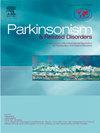Protective role of apolipoprotein A and B in Parkinson's disease: A prospective study from UK Biobank
IF 3.1
3区 医学
Q2 CLINICAL NEUROLOGY
引用次数: 0
Abstract
Introduction
Evidence have indicated relation between apolipoproteins and neurodegenerative disorders (NDDs). However, previous studies have produced inconsistent results, and a comprehensive analysis of apolipoproteins in NDDs is currently lacking.
Methods
Using Cox proportional hazards regression analysis based on data from UK Biobank, we examined the association between baseline serum levels of apolipoprotein A (ApoA) and apolipoprotein B (ApoB) and risk of Parkinson's disease (PD), Alzheimer's disease, amyotrophic lateral sclerosis, frontotemporal dementia, and multiple sclerosis.
Results
Elevated baseline levels of serum ApoA (HR = 0.84, 95 % CI: 0.71–0.99, P = 0.047) and ApoB (HR = 0.67, 95 % CI: 0.57–0.78, P = 3.18E-07) were associated with a reduced risk of incident PD. Subgroup analyses suggested the protective effect of serum ApoA was more significant for older participants and those with lower alcohol consumption, while higher serum ApoB was a more significant protective factor in males and those without stroke. No significant associations were found between apolipoproteins and other NDDs.
Conclusion
Increased baseline levels of serum ApoA and ApoB are linked to a lower risk of PD. These findings enhance understanding of the role of apolipoproteins in PD, and have implications for the development of therapeutic strategies in clinical trials.
载脂蛋白A和B在帕金森病中的保护作用:来自英国生物银行的一项前瞻性研究
有证据表明载脂蛋白与神经退行性疾病(ndd)有关。然而,以往的研究结果并不一致,目前缺乏对ndd患者载脂蛋白的全面分析。方法:基于UK Biobank的数据,采用Cox比例风险回归分析,研究了血清载脂蛋白A (ApoA)和载脂蛋白B (ApoB)的基线水平与帕金森病(PD)、阿尔茨海默病、肌萎缩侧索硬化症、额颞叶痴呆和多发性硬化症风险之间的关系。结果:血清ApoA (HR = 0.84, 95% CI: 0.71-0.99, P = 0.047)和ApoB (HR = 0.67, 95% CI: 0.57-0.78, P = 3.18E-07)基线水平升高与PD发生风险降低相关。亚组分析表明,血清载脂蛋白a的保护作用对老年人和饮酒量较低的人更为显著,而血清载脂蛋白b较高的人对男性和没有中风的人更有保护作用。载脂蛋白和其他ndd之间没有明显的关联。结论:血清载脂蛋白a和载脂蛋白b基线水平的升高与帕金森病风险的降低有关。这些发现增强了对载脂蛋白在帕金森病中的作用的理解,并对临床试验中治疗策略的发展具有重要意义。
本文章由计算机程序翻译,如有差异,请以英文原文为准。
求助全文
约1分钟内获得全文
求助全文
来源期刊

Parkinsonism & related disorders
医学-临床神经学
CiteScore
6.20
自引率
4.90%
发文量
292
审稿时长
39 days
期刊介绍:
Parkinsonism & Related Disorders publishes the results of basic and clinical research contributing to the understanding, diagnosis and treatment of all neurodegenerative syndromes in which Parkinsonism, Essential Tremor or related movement disorders may be a feature. Regular features will include: Review Articles, Point of View articles, Full-length Articles, Short Communications, Case Reports and Letter to the Editor.
 求助内容:
求助内容: 应助结果提醒方式:
应助结果提醒方式:


